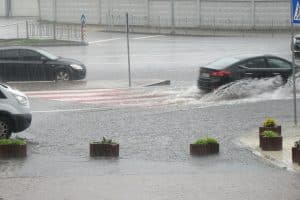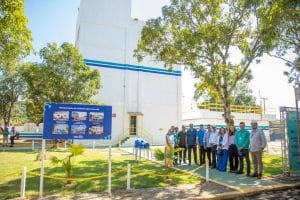A Região de San Diego/Califórnia importava 95% de água para seu abastecimento nos últimos 25 anos. Investimentos em tecnologias como dessalinização, reduziu este índice para 57%, a meta é chegar em apenas 18% nos próximos 20 anos. A situação da cidade mudou de uma das áreas mais vulneráveis durante a seca para uma das mais bem preparadas do estado, sendo inclusive, um modelo de uso de água para o futuro.
Outras cidades ao redor do planeta passam por dificuldades durante o crescimento populacional e mudanças climáticas. De acordo com a Nações Unidas, 800 milhões de pessoas vivem sem acesso a água potável, e este número pode aumentar para 1.8 bilhão em 2025.
Confira a reportagem produzida pelo The Wall Street Journal sobre tecnologias e ações tomadas para solucionar as questões de abastecimento de água:
SAN DIEGO—A quarter-century ago, San Diego and its suburbs imported 95% of their water supplies. Thanks to investments in desalination and other efforts to boost supplies, that figure has already dropped to 57% and is projected to fall to just 18% sometime in the next two decades.
San Diego has gone from being one of the most vulnerable areas of California during drought to one of the best prepared—and in so doing has become a model for the future of water use in cities. Even as water supplies have dwindled in many other parts of California during the current drought, San Diego has stockpiled enough to help replenish a local reservoir. The turnabout came, local officials say, after San Diego faced mandatory cutbacks of as much as 50% during another severe drought in 1991.
“The call was, ‘Never again,’ ” says Robert Yamada, director of water resources for the San Diego County Water Authority, the major wholesaler to the metropolitan area of 3.2 million.
Many other cities around the world face scarce water supplies amid soaring population growth, including in some of the planet’s driest regions. According to the United Nations, about 800 million people don’t have access to clean water, and that could jump to 1.8 billion by 2025. Warming temperatures are expected to put more stress on supplies, such as by melting glaciers that some communities rely on for water.
“Many cities are not keeping up with things the way they are, and climate change will make it worse,” says Martin Gambrill, a lead water and sanitation specialist for the World Bank.
San Diego’s approach shows that cities can cope, but often at a price. In all, water officials in the metro area have overseen more than $2 billion in investments to help wean the city’s dependence on water being transported hundreds of miles from Northern California and the Colorado River. That has resulted in the cost of treated water more than doubling to $1,365 an acre-foot in 2015 from $505 in 1990, according to the county water authority. Those costs have been passed along to users in the form of higher rates.
Desalination plants
One of the more expensive new sources came from a $1 billion desalination plant developed and owned by Boston-based Poseidon Water LLC as part of a partnership with the county water authority. San Diego turned to desalination in part because—unlike many other cities—it has relatively small aquifers to store water, says Maureen Stapleton, general manager of the county water authority.
“What we do have available to us is the Pacific Ocean,” she says.
After three years of construction on the coast in Carlsbad, Calif., the plant began operations in December to provide about 50,000 acre-feet of drinkable water annually, or roughly 10% of San Diego County’s water supply. An acre-foot is enough water for a family of five for one year.
The number of desalination plants that separate salt from ocean or brackish water has soared around the world, with an estimated 18,426—including plants of different sizes and uses—providing all or part of the needs of 300 million people, according to the International Desalination Association, an industry trade group in Topsfield, Mass.
Desalination plants in Israel generate nearly half the country’s water supply, and others have opened in cities including Sydney and Singapore. A big desalination plant reopened in Gibsonton, Fla., in 2008, serving the Tampa Bay area.
Such plants have drawbacks, including high energy costs. Critics of desalination also contend the plants hurt the environment by, among other things, using large amounts of electricity and sucking fish eggs into water-intake pipes. Plant operators say the pipes are equipped with screens to minimize ocean kill.
Another technique San Diego and some other cities around the world are using is patching leaks to augment water supplies. Their techniques include installing corrosion-resistant valves on water lines and deploying teams of inspectors to detect leaks. As much as a trillion gallons of water is wasted annually to household leaks in the U.S. alone, or enough to supply more than 11 million homes, according to the Environmental Protection Agency.
In the Philippines, parts of greater Manila in 2007 were losing as much as two-thirds of their water mostly due to leaks. One of the local water utilities in 2009 contracted with a company to use meters and other methods to detect leaks, resulting in the water losses falling to 41% by 2012 at a saving of 166 million gallons a day, according to the International Water Association, a nonprofit based in London.
Lining Canals
San Diego’s water authority took a different approach, developing a program to reduce leaks in a nearby agricultural area. Under a 2003 deal with several parties, the authority gained access to water that it helped conserve by lining sections of two irrigation canals carrying Colorado River water to two desert farming areas in southeastern California. After the $400 million projects were completed in 2010, San Diego began receiving about 80,000 acre-feet of saved water annually, or approximately 15% of its supply.
Having enough space to store water when it isn’t needed is also a growing priority for many cities, and one that some have started to address by expanding the capacity of local dams. In Australia, water officials raised the level of Chaffey Dam serving the nearby city of Tamworth by 26 feet in 2014, while Japanese officials in 2006 raised the level of the Shimonohara Dam serving Nagasaki by 85 feet.
San Diego undertook one of the biggest reservoir-expansion projects in the world when the county water authority between 2009 and 2014 raised the level of the 220-foot-high San Vicente Dam by 117 feet. The work, which cost about $400 million, more than doubled the capacity of the reservoir from 90,000 to 242,000 acre-feet—providing the San Diego area another buffer against shortages, local officials say. The reservoir increases the system’s ability to capture runoff and store untreated water imports, too.
“This gives us so much flexibility in operations of our water,” says Jesus Meda, deputy director of water system operations for the city of San Diego, which operates the expanded reservoir with the county water authority.
While this dam-raising didn’t meet a lot of controversy, others have. The federal Bureau of Reclamation has been studying the idea of raising California’s 602-foot-high dam at Shasta Lake for nearly four decades and settled on a plan to do so by 18.5 feet. But regulatory delays and pushback by critics over issues including tribal rights have prevented it from happening. A small Indian tribe has its ancestral home along the shores of Shasta Lake and is worried the land will be inundated by rising waters from the dam expansion.
Water officials in San Diego and elsewhere say there is no one way cities are likely to resolve their future water challenges. “We don’t see silver bullets as the answer to water reliability,” Ms. Stapleton says. “We see it as a multifaceted approach.”
Fonte: www.wsj.com
































